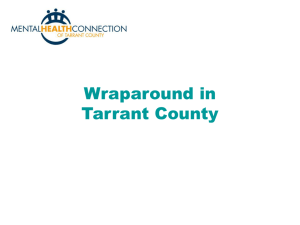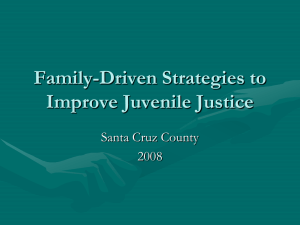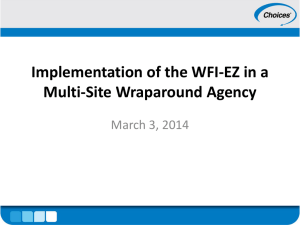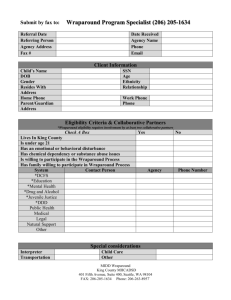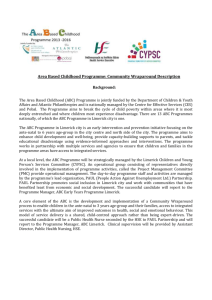Service Delivery Models
advertisement
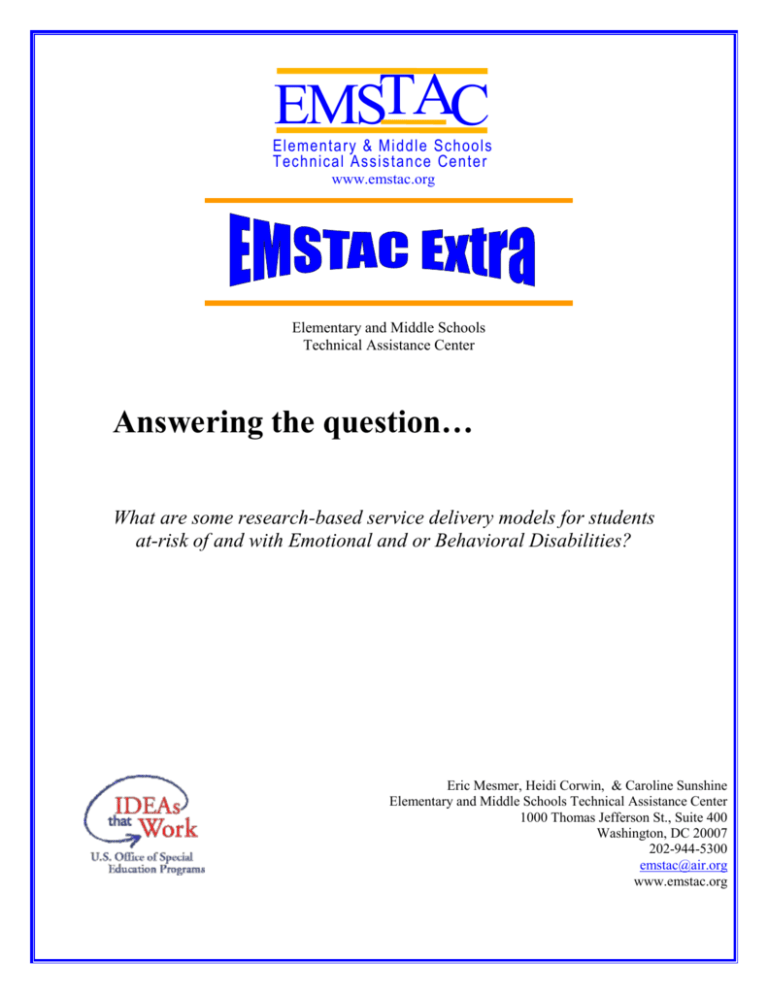
EMSTAC Elementary & Mi ddle Schools Technical Assis tance Center www.emstac.org Elementary and Middle Schools Technical Assistance Center Answering the question… What are some research-based service delivery models for students at-risk of and with Emotional and or Behavioral Disabilities? Eric Mesmer, Heidi Corwin, & Caroline Sunshine Elementary and Middle Schools Technical Assistance Center 1000 Thomas Jefferson St., Suite 400 Washington, DC 20007 202-944-5300 emstac@air.org www.emstac.org EMSTAC Service Delivery Models for Students at-risk of and with Emotional and or Behavioral Disabilities: Abbreviated Review and Resources This document provides a general overview of prevalent service delivery models intended to address the needs of students with emotional and behavioral disabilities and those considered at risk of significant emotional or behavioral difficulties. The information provided is not intended to comprehensively cover all possible models; instead this document focuses on two models that have become prevalent both in the professional literature and in practice during the past 10 years. The information presented on these two models reflects a continuum of service that is considered “best practice” for addressing the needs of students whose emotional/behavioral/social difficulties range in severity. The two models include Positive Behavior Supports and Wraparound Services. It is important to recognize that these two models share a common goal of attempting to meet individual student needs within the least restrictive environment that is considered appropriate. However, one model is highly specialized in its focus on students with severe emotional and/or behavioral disabilities while the other model is more general as it focuses on improving social and behavioral outcomes by building a school’s capacity to prevent difficulties from occurring and proactively addressing those that do. Interestingly, while these models are complementary, documentation of their simultaneous implementation within one district, in a well-integrated fashion, is difficult to find. Such an integrated approach, however, may ultimately be most beneficial in addressing social and emotional needs that range in severity. Before specifically discussing Positive Behavior Supports and Wraparound Services a number of service components that may be incorporated in all delivery models for students with emotional or behavioral disabilities is presented. These components, introduced by Quinn and McDougal (1998), are presented because each of these components is represented when considering implementation of Positive Behavior Supports and Wraparound Services within one model of service delivery: “School – based Best Practices” – The use of instructional/curricular and behavioral interventions that are individualized and empirically validated will serve as an important component within a comprehensive intervention plan. School-based interventions are varied and may include modifications to the instructional environment, provision of consultation services to teachers and others who work directly with these students, direct services to the students themselves (counseling, skill training etc.), crisis intervention, and transitional planning. “Comprehensive Individualized Care” – Particularly in the case of students with severe needs, it is likely that a number of services will need to be provided that go beyond that which can be offered by the educational system. Comprehensive care may include the involvement of social service or family preservation agencies, mental health, medical, juvenile justice, as well as the education system. 2 “Interagency Collaboration” – Because various agencies and service providers are likely to be involved in meeting the needs of an individual student and his or her family it is critical that an intervention plan is developed among these providers in a collaborative fashion. Each service agency is likely to have different goals and resources to address those goals. It is important that providers from each agency have an opportunity to provide input into how the other agencies’ resources and goals may be most beneficial to the child and his/her family and that barriers are addressed in a mutually agreed upon fashion. “Service Coordination” – Interagency collaboration will help ensure that services are well coordinated so that they maximally benefit the child and his/her family. A designated “case manager” or “service coordinator” can ensure that intervention progress or barriers within one setting can be communicated to the other settings so adjustments to intervention services within those agencies can be modified as appropriate or needed. Educational personnel such as school psychologists or social workers may logically fill this role due to their familiarity with and accessibility to the other systems and due to the fact that the child is likely to interface with the educational system on a daily basis. “Family Centered Services” – Services should take into account the needs of the whole family, not just the child. This is important because the home environment is likely to have the single greatest impact on the child’s ability to benefit from services. In many cases mental health, health, or other services will need to provided to the family if they are to be involved in the intervention for their child. Further, the services that are provided should be sensitive to the family’s culture and ethnicity. As can be seen in Figure 1, although different in some regards, Positive Behavior Supports (PBS) and Wraparound Services are complementary in that they blend a wide array of interventions that cross the spectrum of need intensity. 3 Figure 1: Illustration of the Complementary Relationship between PBS and Wraparound Intensity of Needs/Services for students with or at risk of EBD At – Risk Mild Prevention Early Intervention Intense Interventions/ Services Screening/Early ID School-wide Supports Effective Instruction Family Support Individual Interventions Individual Assessment Collaboration Crisis Intervention Interagency Planning Flexible Funding Community Based Services Comprehensive Support Reintegration Moderate Service Delivery Model Positive Behavior Supports Severe Service Delivery Model Wraparound Supports School – Based Prevention and Intervention Community -Based Interagency Support 4 Service Delivery Models: Positive Behavior Supports and Wraparound Services Wraparound Services Wraparound is a system of care in which families and all appropriate service providers such as mental health providers, community organizations, and school professionals collaborate to provide a support system to keep children with emotional/behavioral disturbances in their communities, homes and schools. The Wraparound philosophy is part of the System of Care Model which strives to work with children in their natural environment to provide individualized and flexible services based on their needs (Eber, Nelson, Miles, 1997). It is also based on family-centered, culturally relevant, strengthsbased and community-based interventions. Wraparound was developed to prevent youth from being referred to educational placements outside of their community or state, and to involve the community and provide individualized services to keep children in their homes and included in their local schools. More recently, the approach has been expanded and adapted to help children in a number of different service delivery systems such as special education, child welfare, juvenile justice, and mental health (Goldman, 1998). A nation-wide Wraparound survey of the State Child Mental Health Directors indicated that 88 percent of states and territories are currently using the Wraparound model. However there is great variability among states in the definition and services provided in the Wraparound programs. Additionally, many states also have alternative names for Wraparound such as, Individualized and Tailored Care, High Risk Intervention, Family Support Services, and Children’s System of Care (Faw, 1998). Early studies on Wraparound indicate that it can reduce the restrictiveness of living and learning situations, reduce the cost of care, and improve social, school and community functioning (Goldman and Faw, 1998). One program of note is a school-based Wraparound program in La Grange Illinois, which has been extremely successful in applying Wraparound services to EBD students in special education (Eber, Nelson, Miles, 1997). Other states that have Wraparound programs that have been researched and evaluated include but are not limited to Vermont, Wisconsin, Maryland, Indiana, Illinois, Kentucky, Alaska, New York, and Florida (Burns, Goldman, Faw, Burchard, 1998) The following three articles either exemplify the implementation of Wraparound programs or provide further details about the Wraparound planning and implementation: 5 1) Eber, L., Nelson, M., and Miles, P (1997) School-Based Wraparound for Students with Emotional and Behavioral Challenges. Exceptional Children, 63 (4), 539-555. School-Based Wraparound for Students with Emotional and Behavioral Challenges provides background information on the Wraparound philosophy, an introduction to implementing Wraparound in schools, and evidence of how the school component of Wraparound services is important in the overall success of the strategy. Eber, Nelson, and Miles explain that the school environment is an optimal place to apply Wraparound so that students can benefit from coordinated interventions without removal from school. Additionally for students involved in special education, the school-based part of the Wraparound plan, which should aim to include all parts of the day where support and intervention are needed, could be translated into an IEP for that child to maximize the resources and the number of planning meetings. The authors also emphasize the importance of supporting teachers and families involved in Wraparound with training, technical assistance, and gaining community support. These supports are an integral part of the success and maintenance of the program. Other components of the article include steps in conducting a Wraparound planning meeting, the evaluation process, and findings from an evaluation of the LADSE EBD Network in LaGrange Illinois. 2) La Grange Area Department of Special Education (1996). LADSE EBD Network: A Continuum of Service Options for students with EBD in Emotional and Behavioral Disabilities Network. This article describes the school-based Wraparound plan that La Grange Illinois public school has developed to serve youth with emotional/behavioral disturbances. The network has been in existence for about seven years and is administered out of the LaGrange Department of Education, which serves 16 schools. The article discusses the three levels of Wraparound services, which include: level one, a special classroom, level two, supported inclusion, and level three, prevention. In all levels, a Wraparound plan is established which addresses assistance to the family, academic tutoring, and building upon the strengths that a child and family already possess. The evaluation of the program in LaGrange for the 1994-1995 school year indicated that of 157 students referred for supports and services for EBD, 43% had a history of out of home placements prior to participation in Wraparound. After participation in wraparound from 1993 to 1995, the percentage of these children placed out of the home dropped to 10%. After one year of participating in the program, 70% of these students were maintained in a less restrictive educational placement. Other components of the program described in the article include quality indicators, a curriculum guide and strategies for applying Wraparound in schools, an eight-step planning process, and information about strengths-based training. Although the evaluation of the LaGrange program was completed for the 1994-1995 school year to provide a sense of how the program began, the LaGrange EDB Network is still in existence today and more information is available at their web site at http://www.ebdnetwork- 6 il.org/. 3) Burns, B.J. and Goldman, S.K. (1998). Executive Summary. In Children’s Mental Health Promising Practices in Wraparound for Children with Serious Emotional Disturbance and Their Families: pp. 11-18. Washington, D.C: Center for Effective Collaboration and Practice, American Institutes for Research. Seven monographs were compiled and presented by the Promising Practices Initiative of the Comprehensive Community Mental Health services for Children and Their Families Program to provide information about how to best serve children with severe emotional and behavioral needs. The executive summary highlights the content and purpose of the seven monographs. Of particular importance in the summary is that in the spring of 1998, a focus group of professionals and stakeholders met at Duke University to achieve consensus on the definition, values, essential elements, and requirements of Wraparound. The definition they came to is as follows: “Wraparound is a philosophy of care that includes a definable planning process involving the child and family that results in a unique set of community services and natural supports individualized for that child and family to achieve a positive set of outcomes” (p. 13). The summary also includes the values, 10 essential elements to Wraparound and 10 practice requirements. According to the report, the initiation of Wraparound has been led by the mental health sector, but the fields of education, welfare, and juvenile justice are beginning to use Wraparound planning to serve children. At the time of the report, Wraparound had been evaluated in nine states through 16 studies. This executive summary is intended to provide a brief and general framework of Wraparound. If you are interested in further detailed information, including specific Wraparound models, a statewide Wraparound survey, information about Wraparound training, etc., you can download the full Report, Promising Practices in Wraparound for Children with Serious Emotional Disturbance and Their Families, containing all seven monographs at the following site: http://www.air.org/cecp/promisingpractices/1998monographs/documents.htm#4 References: Burns, B. J., Goldman, S. K., Faw, L., Burchard, J. D. (1998). The Wraparound Evidence Base. In Promising Practices in Wraparound for Children with Serious Emotional Disturbance and Their Families: pp. 95-118. Washington, D.C: Center for Effective Collaboration and Practice, American Institutes for Research. Eber, L., Nelson, C.M., & Miles, P. (1997). School-based wraparound for students with emotional and behavioral challenges. Exceptional Children, 63(4), 539-555. Faw, L.(1998).The State Wraparound Survey. In Children’s Mental Health: Promising Practices in Wraparound for Children with Serious Emotional Disturbance and Their Families: pp. 34-60. Washington, D.C: Center for Effective Collaboration and Practice, American Institutes for Research. 7 Goldman, S. K. (1998). The Conceptual Framework for Wraparound. In Promising Practices in Wraparound for Children with Serious Emotional Disturbance and Their Families: pp. 34-60. Washington, D.C: Center for Effective Collaboration and Practice, American Institutes for Research. Goldman, S. K. & Faw, L. (1998). Three Wraparound Models as Promising Approaches: LaGrange, IL. In Promising Practices in Wraparound for Children with Serious Emotional Disturbance and Their Families: pp. 34-60. Washington, D.C: Center for Effective Collaboration and Practice, American Institutes for Research. 8 Positive Behavior Supports Many students with emotional and/or behavioral disabilities will thrive academically, socially, and behaviorally in environments that are predictable and structured, and that provide support that teaches and reinforces prosocial behavior. Positive behavior support (PBS) programs are generally implemented school-wide and promote positive behavior in students. These models also emphasize the development of individualized interventions for students who need additional support. Frequently this includes students who have been identified with an Emotional and/or Behavioral Disability. Through multiple layers of coordinated, proactive, and positive supports, PBS models can be effective as a model for meeting the educational, social, and behavioral needs of students with EBD. Positive behavior support is the application of behavior analysis to achieve sustained, socially adaptive behavior change. PBS was initially developed as an alternative to aversive interventions, such as paddling, that were used with students with severe disabilities who engaged in extreme forms of self-injury and aggression (Durand & Carr, 1985; Meyer & Evans, 1989). More recently, the intervention has been successfully applied with a wide range of students, in a wide range of contexts (Carr et al., 1999; Horner, Albin, & O'Neill, 1991). It has also transformed from an intervention for individual students to an intervention approach that includes entire schools (Colvin, Sugai, Good, & Lee, 1996; Colvin, Kame'enui & Sugai, 1993; Lewis, Colvin, & Sugai, in press; Lewis, Sugai & Colvin, 1998; Taylor-Greene, et al., 1997; Todd, Horner, Sugai, Sprague, 1999; Sugai, Sprague, Horner, Walker, in press). PBS is an application of a behaviorally-based, multi-systemic approach to enhance the capacity of schools, families, and communities to effectively implement researchvalidated practices that support the development of positive behaviors. Attention is focused on creating and sustaining school environments that enhance lifestyle results for all students, in a variety of areas (i.e., personal, health, social, family, work, recreation, etc.). The goal of PBS is to replace problematic behavior with more appropriate behavior that serves to meet the same function as the problematic one(s). Additionally, the use of culturally appropriate interventions is emphasized. In summary, Haring and De Vault (1996) indicate that PBS is comprised of (a) "interventions that consider the contexts within which the behavior occurs"; (b) "interventions that address the functionality of the problem behavior"; (c) "interventions that can be justified by the outcomes"; and (d) "outcomes that are acceptable to the individual, the family, and the supportive community" (p. 116). A number of states are trying out PBS-related interventions, including Oregon, Utah, Kansas, Kentucky, Missouri and Florida. 9 The following summarizes articles that exemplify PBS programs and offer concrete strategies for implementing PBS. 1) Center for Effective Collaboration and Practice 2001, Behavioral and Educational Strategies for Teachers (BEST). Retrieved from the Center for Effective Collaboration and Practice Web site: http://www.air.org/cecp/resources/success/best.htm BEST is a professional development program whose goal is to bring general and special educators together to work with students who are behaviorally challenging in the least restrictive setting possible. The program does this by providing model demonstration sites that address local needs and new research-based approaches; offering on-site training and technical assistance, ongoing curricula development, and training and technical assistance programs that link staff members with one another and with expert consultants. In addition, the project makes a concerted effort to develop practices and procedures that efficiently coordinate with other provider agencies to offer a comprehensive system of trans-agency services for students with behavior problems. For instance, one middle school in the Granite School District in Utah employs BEST training to enable its staff to use positive and proactive approaches to school- and classwide behavioral management. The school has creatively transformed self-contained classrooms into settings that support students to work successfully as they return to mainstream settings. Also, the school uses a specialist in behavioral disorders (the same teacher who staffs the self-contained classroom) to track student performance, provide ongoing training and consultation to general educators, and provide crisis intervention when necessary. 2) Ruef, M.B., Higgins, C., Glaeser, B.J.C., & Patnode, M. (1998). Positive behavioral support: Strategies for teachers. Intervention in School and Clinic, 34 (1), 21-32. This article describes (1) what PBS is, (2) the value of exploring why a student exhibits challenging behavior, and (3) key PBS strategies teachers can implement in classrooms. In describing what PBS is, the article emphasizes that it is a comprehensive, researchbased approach to producing lasting change for students with challenging behavior. Also, it maintains that while teachers often favor behavioral strategies that are quick and that immediately produce results, the strategies that are more likely to generate more longlasting results are time intensive. These strategies require teachers to determine what the problem is – where, when, how, and why the behavior occurs (e.g., frustration, escape, desire for attention, boredom, control, etc.) – and then use strategies for teaching new and more constructive behavioral skills. This is the cornerstone of PBS. Strategies for implementing PBS include the following: 10 (1) Alter the classroom environment to accommodate individual student environmental needs. This can include seating students who are easily distracted away from noisy, high-traffic areas, seating students who are hard of hearing up front, and so on. (2) Increase predictability and scheduling. Examples include creating a routine daily schedule and making students aware of it; establishing separate, individualized routines for students whose attention spans are limited; and alerting students before transitions from one activity to another to increase the likelihood of appropriate behavior. (3) Increase choice-making. Providing students with challenging behavior the opportunity to make choices is one way of teaching them that they can influence others without having to resort to inappropriate behavior. By empowering students to make choices, teachers can help lessen student feelings of powerlessness. (4) Make curricular adaptations to enhance student performance in completing activities and reduce the likelihood of challenging behaviors. This can mean adjusting the nature of the task or activity (i.e., shortening the length of instruction time, task variation, planning preferred activities to occur consistently); adjusting the method of presentation (i.e., using different modalities, employing self-monitoring tactics); or some combination of these. (5) Appreciate positive behaviors. Determining the right reward, reducing rewards over time, and keeping rewards interesting are all principles of positive reinforcement, or teaching a person to act in a certain way by rewarding that person for appropriate behavior. Positive reinforcement has proved to be an important part of the learning process. (6) Teach replacement skills. When the purpose behind the problematic behavior is ascertained, students need to be taught appropriate behavior that is likely to fulfill the same objective as the problematic behavior. References Carr, E. G., Horner, R. H., Turnbull, A. P., Marquis, J. G., Magito-McLaughlin, D., McAtee, M.L., Smith, C.E., Ryan, K.A., Ruef, M.B., and Doolabh, A. (1999). Positive behavior support as an approach for dealing with problem behavior in people with developmental disabilities: A research synthesis. Washington, DC: American Association on Mental Retardation Monograph Series. Center for Effective Collaboration and Practice 2001, Behavioral and Educational Strategies for Teachers (BEST). Retrieved from the Center for Effective Collaboration and Practice Web site: http://www.air.org/cecp/resources/success/best.htm Colvin, G., Kame'enui, E. J., & Sugai, G. (1993). School-wide and classroom management: Reconceptualizing the integration and management of students with behavior problems in general education. Education and Treatment of Children, 16, 361-381. 11 Colvin, G., Sugai, G., Good, R. H., III, & Lee, Y. (1997). Using active supervision and precorrection to improve transition behaviors in an elementary school. School Psychology Quarterly, 12, 344-363. Durand, M. V. & Carr, E. G. (1985). Self-injurious behavior: Motivating conditions and guidelines for treatment. School Psychology Review, 14, 171-176. Haring, N. G. & De Vault, G. (1996). Family issues and family support: Discussion. In L. K. Koegel, R. L. Koegel, G. Dunlap (Eds.), Positive behavioral support: Including people with difficult behavior in the community (pp. 116-120). Baltimore, MD: Paul H. Brookes Publishing Co. Horner, R.H., Albin, R.W., O'Neill, R.E. (1991). Supporting students with severe intellectual disabilities and severe challenging behaviors. In G. Stoner, M.R. Shinn, H.M. Walker (Eds.), Interventions for achievement and behavior problems, (pp. 269-287). Washington DC: National Association of School Psychologist. Lewis, T. J., Colvin, G., Sugai, G. (in press). The effects of pre-correction and active supervision on the recess behavior of elementary school students. School Psychology Quarterly. Lewis, T. J, Sugai, G., Colvin, G. (1998). Reducing problem behavior through a schoolside system of effective behavioral support: Investigation of a school-wide social skills training program and contextual interventions. School Psychology Review, 27, 446-459. Meyer, L. H. & Evans, I. M. (1989). Nonaversive intervention for behavior problems: A manual for home and community. Baltimore, MD: Paul H. Brookes Publishing Co. Ruef, M.B., Higgins, C., Glaeser, B.J.C., & Patnode, M. (1998). Positive behavioral support: Strategies for teachers. Intervention in School and Clinic, 34(1), 21-32. Sugai, G., Sprague, J.R., Horner, R.H., & Walker, H.M. (in press). Preventing school violence: The use of office discipline referrals to assess and monitor school wide discipline interventions. Journal of Emotional and Behavioral Disorders. Taylor-Greene, S., Brown, D., Nelson, L., Longton, J., Gassman, T., Cohen, J., Swartz, J., Horner, R. H., Sugai, G., & Hall, S. (1997). School-wide behavioral support: Starting the year off right. Journal of Behavioral Education, 7, 99-112. Todd, A. W., Horner, R. H., Sugai, G., & Sprague, J. R. (1999). Effective behavior support: Strengthening school-wide systems through a team-based approach. Effective School Practices, 17(4), 23-37. 12

